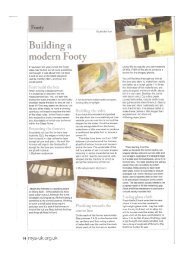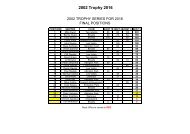Create successful ePaper yourself
Turn your PDF publications into a flip-book with our unique Google optimized e-Paper software.
and fell in love with the class. I then decided to look for a<br />
wreck of a Six, which I soon found in Cornwall, which I could<br />
restore in our garden in Saint-Tropez. She was K 75 Joanna, ex-<br />
G 24 Michel Selig and Avalun VIII.<br />
D. Michel Selig<br />
1. History<br />
Michel Selig at the Ocean Yacht Co. boatyard in<br />
Cornwall at the time of purchase<br />
First her name: G 24 Michel Selig, G 24 being her sail<br />
number.. It remains an unknown. Literally, it means<br />
Michael the Blessed. No German speaker I've met has<br />
come up with an explanation.<br />
She was commissioned by Hans Collignon, a prosperous<br />
printer and active yachtsman who sailed on the Wannsee, a<br />
lake on the outskirts of Berlin. He intended to enter her in<br />
the June 1936 German elimination trials for the upcoming<br />
Olympic Games, whose sailing activities were located at<br />
Kiel, just to the east of Denmark.<br />
For some unknown reason, he commissioned Reinhard<br />
Drewitz, probably the world's best designer of sailing<br />
dinghies of the period, as architect. Drewitz must have told<br />
Colllignon that he was no match for successful 6mR<br />
architects like Anker, etc. (see above). He may have<br />
convinced Collignon to make a bet on the weather.<br />
The Berlin boatyard of Wilhelm Buchholz built her. She is<br />
the only Berlin built Six.<br />
In June, the weather in Kiel is usually quite windy. There is<br />
a 10% chance that the Scandinavian high will descend to<br />
Kiel bringing calm breezes. Drewitz may have said that he<br />
could design a Six optimized for low wind speeds and thus<br />
perhaps faster than the other Sixes with their general<br />
purpose all weather design.<br />
His design was a Six that resembled a centreboard sailing<br />
dinghy. In the formula of the International Rule above, the<br />
variable "d" corresponds to a penalty for having a wineglass<br />
shaped cross section, rather than a rounded one. Drewitz's<br />
centreboard shape resulted in a severe penalty. To<br />
compensate for it, he designed the boat to float bow down,







